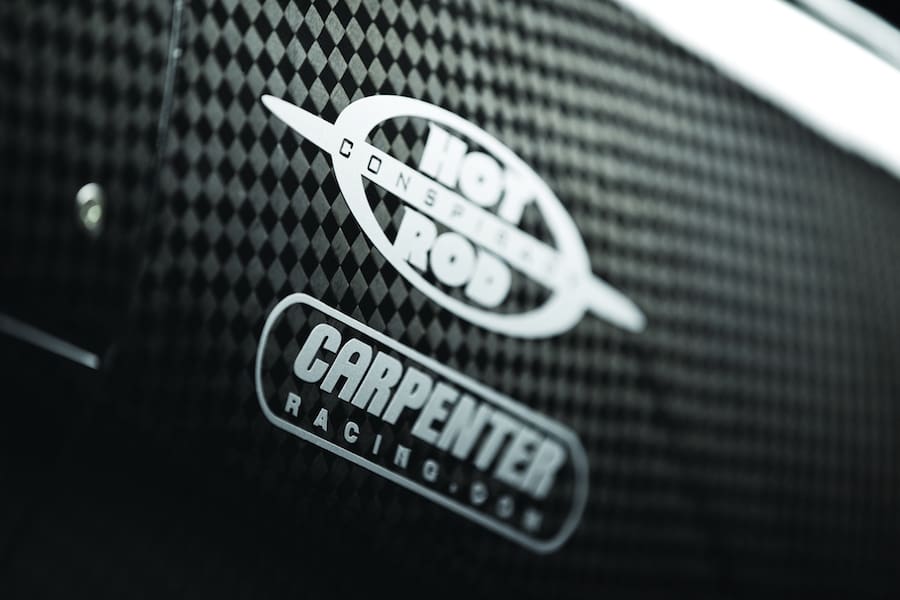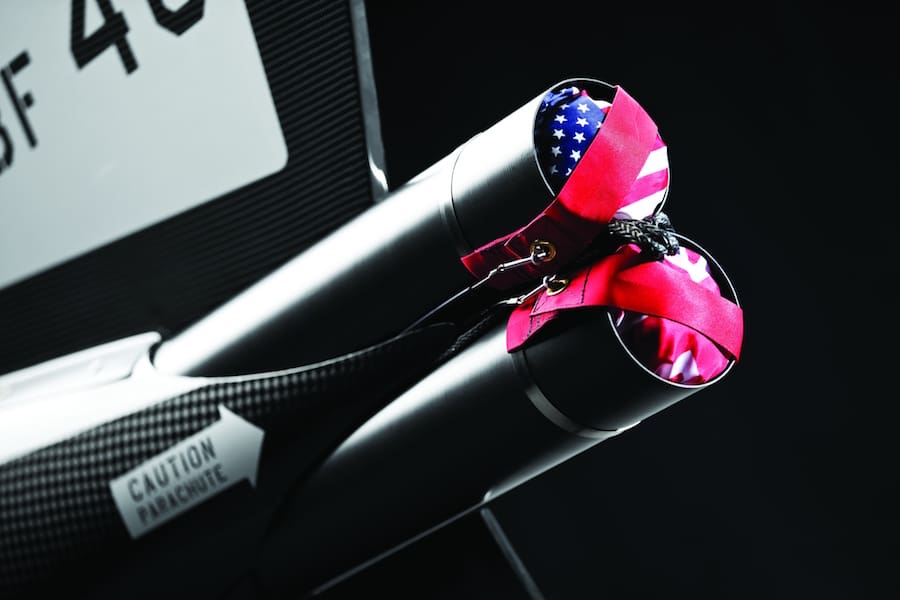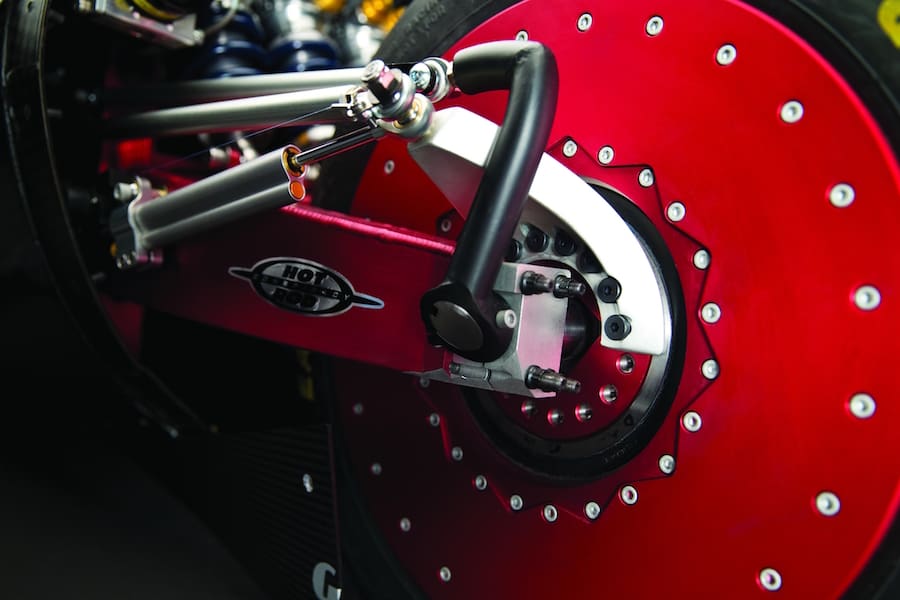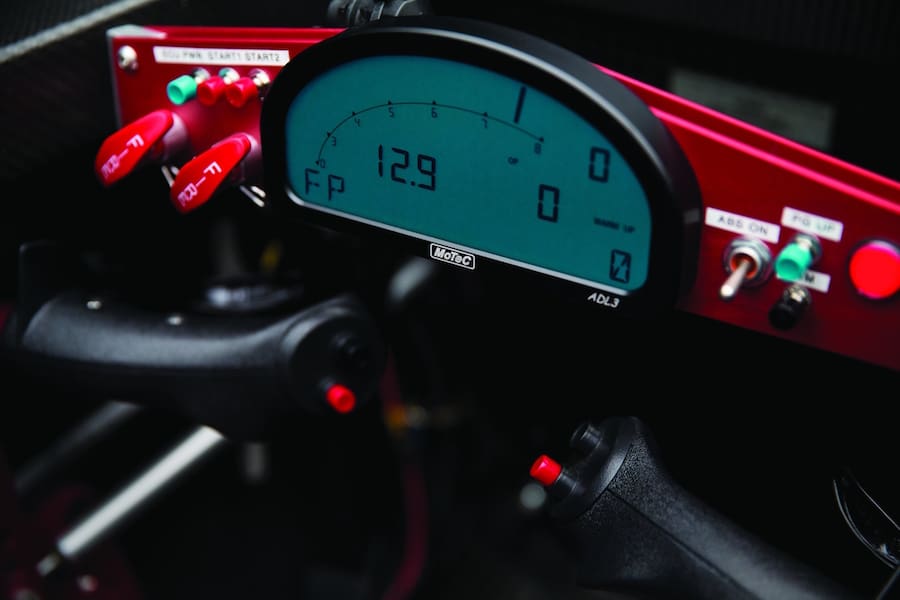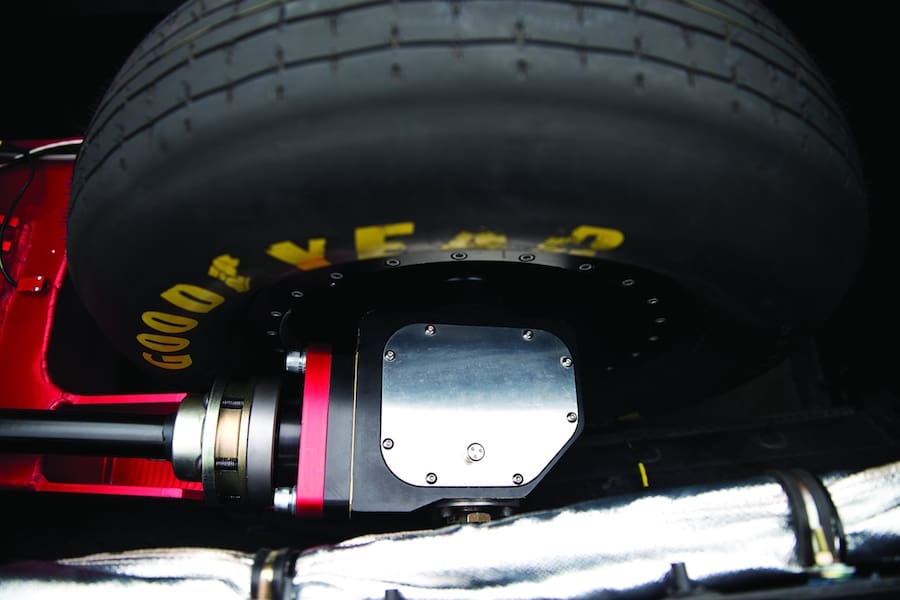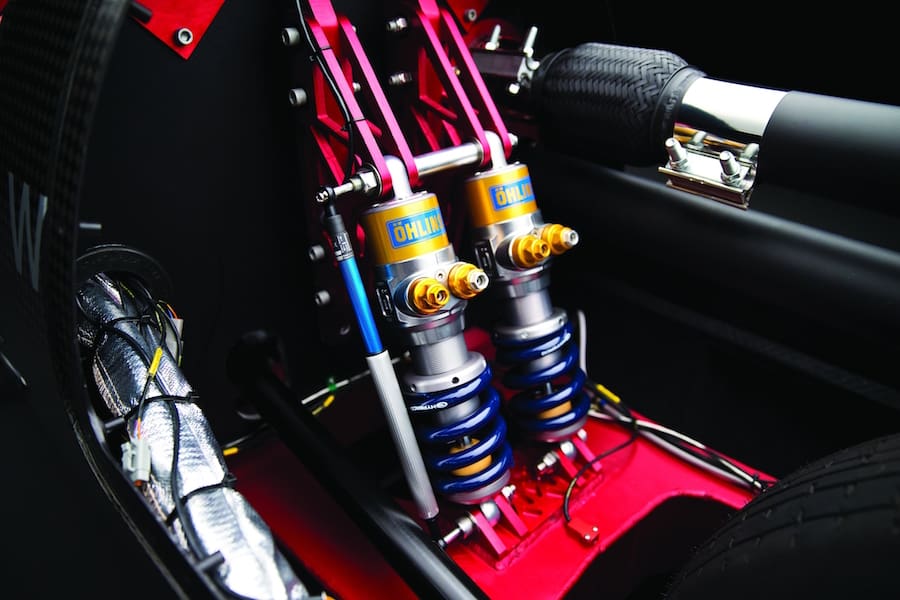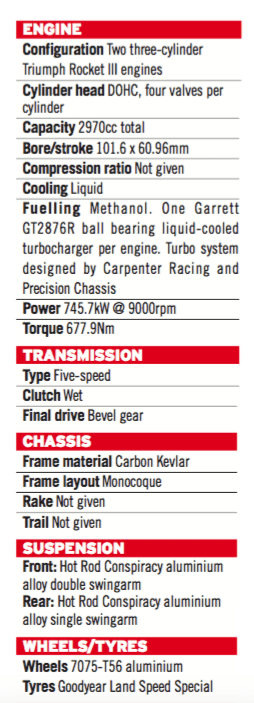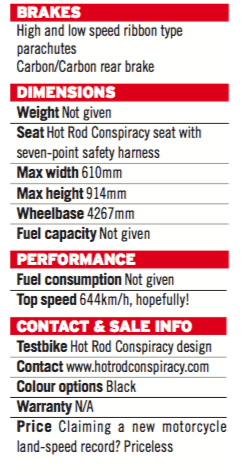Fastest motorcycle ever? Exactly 60 years ago on 6 September 1956, American rider Johnny Allen set a new two-wheeled world land-speed record of 214.4mph (345.188km/h) on the Bonneville Salt Flats in the so-called Texas Ceegar. This streamliner was built in Dallas, Texas by Stormy Mangham and powered by an unsupercharged 650cc Triumph Thunderbird twin-cylinder motor tuned by fellow Texan Jack Wilson. Two years later, the Triumph Bonneville streetbike was launched by the British manufacturer in recognition of that achievement, and has arguably become the most iconic model produced by any European manufacturer since that time.
Now, six decades later, British road racer and TV personality Guy Martin is attempting to regain the ‘world’s fastest’ accolade for Triumph on the Bonneville Salt Flats in another streamliner built with American ingenuity, this time in Portland, Oregon by mechanical engineer Matt Markstaller and his colleagues at Hot Rod Conspiracy. It’s powered by two turbocharged Rocket III engines coupled together, which have been de-stroked by New Jersey-based drag race tuner Bob Carpenter to a total combined capacity of 2970cc, and tuned by him to produce 1000bhp (745.7kW).
Matt tells us the story of how the world record attempt and the Triumph Infor Rocket Streamliner came together…
A decade ago I began working at Freightliner Trucks and designed and built a wind tunnel for them to test trucks in. For fun, we put in a shorter test section in front to test various other stuff, like motorcycles. I’ve known George Latus for a long time, and I suggested he should bring some of his bikes in, so he brought in his new Triumph 675R racebikes. He’d been racing Ducatis in his road-race team, and Jason DiSalvo won the Daytona 200 on a Latus Racing Ducati, but for 2012 George switched to Triumph and was starting from ground zero. He brought in the bikes and while we were testing them in the wind tunnel, George asked me about Bonneville – he knew I’d been going there on and off since college, and he said he’d love to go there one day himself. I said I was up for anything he wanted to do, so then he called me back about six weeks later, and told me he’d talked to Greg Heichelbech, who was then President of Triumph North America, and Greg had said they’d love to help us go after the outright world land-speed record. So it all started with that conversation, and the person who gets the credit for dreaming this entire thing up is George Latus.”
“While we were starting to think about building the Streamliner, I suggested that we should look through the record book for something to aim at, so we could go to Bonneville and get some experience running motorcycles there. There aren’t a lot of 2000cc-plus bikes around, and the records for that class were pretty obtainable. So we went to the Salt Flats in 2012, and got the AMA Modified Production record as well as the FIM 3000cc Unstreamlined record on a stock Rocket-3 we’d prepared, with Jason DiSalvo riding. Triumph North America came out to watch us, and they loved it. Triumph is very sensitive about its Bonneville heritage, and had been looking for an opportunity build on it. This Streamliner project is a way for them to repeat history 60 years later.”
“So we got the green light to start work on the Streamliner right after Bonneville 2012. They asked me what I needed, and we got some sponsorship from Castrol and a few others, as well as from Triumph themselves. From that I was able to pay for building the thing – I’ve got a lot of my own time in it, but not a lot of my own money. It took me and four other guys five months to do all of the Computational Fluid Dynamics work and design the final shape of the bike – the initial shape started out quite differently, and at 400mph it’s supremely important to get that right. A streamliner motorcycle is not a conventional vehicle, so to progress from ground zero I looked at other streamliners – the AckAttack, the BUB Seven and the EZ-Hook, and they all have a fairly logical layout. But while the EZ-Hook and the AckAttack both had a tube frame with a body over them, I’d studied composites in college, so I’m very familiar with the monocoque designs of Formula 1 racing cars, and to me there was never any other way to do it.
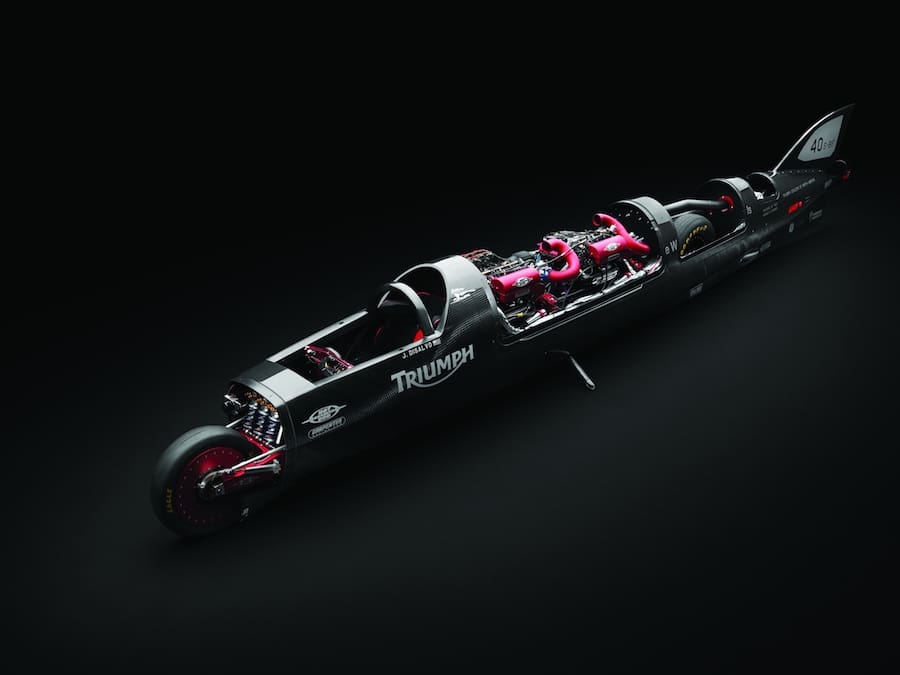
So the Triumph Streamliner has a carbon Kevlar monocoque, which is oven-baked in an autoclave, using pre-preg material. I was personally responsible for the overall packaging, the overall design, and the overall layout, but I had support from others with Finite Element Analysis (FEA) to optimise the plies and everything. The frontal area of the vehicle is basically determined by the engines – and these are big engines. So we packaged these in as small a diameter structure as we could, and then the driver fits in front of that.
There are two issues you address in designing a vehicle to go fast: speed, and safety. I’ve watched many videos of other streamliners crashing, and what happens is that they tip over, then slide along on their side for a little while, until a body panel flies off. As soon as that happens you get a sharp edge, and it digs in and tumbles, or else pencil rolls. To me, the monocoque was such a natural way to avoid that. Carbon fibre is just so amazing in terms of stiffness to weight – our basic monocoque tub weighs less than 400lb [180kg]. Okay, light weight is not necessarily an advantage on the salt, because you want weight for traction, but it’s an advantage for us because we can position the weight where we want it. The monocoque structure gives us a great advantage in strength, safety and aerodynamics. All of the panels that are detachable are perimeter bolted, so everything is as strong as everything else. Our FEA shows us that this vehicle can bounce along at 40g without destructing, and the driver can take 25g before he is compromised.
We also did a regular motorcycle stability analysis. Perhaps surprisingly, the only company I could find to do this was DinaMoto in Italy, who do a lot of work on MotoGP bikes. Their program is called FastBike3D, and the analysis showed that we had to rebalance a lot of things. The results came back that this thing we’d designed was going to go into a weave mode at 250mph, which was no good at all! So we had to shift some weight around and stiffen the chassis – they tell us that despite its long 14-foot [4267mm] wheelbase, our Triumph Streamliner is as stiff between the wheels as a MotoGP bike, which is excellent.
However, we can adjust the wheelbase depending on where we want to move the centre of gravity (CG). Aerodynamically, it’s important to have the CG ahead of the centre of pressure (CP), but not too far. If you throw an arrow backwards, the CP is ahead of the CG, and it wants to turn around. YouTube some of those streamliner crashes and you can tell that this is exactly what they wanted to do. For the chassis rigidity, we have billet aluminium swingarms front and rear, each machined out of a single block of metal in a C-channel, then with a plate welded on to box it in, making a very strong but light component. Then we have three Öhlins shocks up front, and a couple out back. Those are regular TTX36s tuned for us by Öhlins – we’re grateful for their help with that. The Triumph’s got twin-stick hub centre steering, again for the rigidity. I went to the Barber Museum and spent a lot of time there looking at the Bimota Tesi, and it’s totally the right way for us to do this.
Brembo didn’t want to release a Formula 1 carbon-carbon brake to us – instead, they wanted to supply us with a superbike metal brake. Well, that’s designed to stop a 400lb [180kg] bike at 200mph, whereas our complete weight fully fuelled ready to race is close to 2000lb [907kg] with driver, going at 400mph, meaning we’d melt that thing instantly. So instead we have a single rear carbon-carbon brake from the drag racing industry which runs very hot, around 2000°F [1095°C], but then it disperses that immediately. This is from a company in California which also makes Space Shuttle brakes, so they’re used to absorbing a lot of energy!
We have aircraft grips on the Streamliner, because they have a number of controls on them. So you have a twist throttle on the right, with a brake lever there too, then we have a clutch on the left, plus push buttons for shifting up and down, while also on the left side we have a switch for moving the landing gear jockey wheels up or down. Those go up at about 20mph, and return on slowdown at the same speed.
We have a MoTeC dash, and two MoTeC ECU modules – one for each engine – which were built here by MoTeC Systems East, rather than at their HQ in Australia. Bob Carpenter is our engine builder, and he’s in New Jersey, so the MoTeC East office in North Carolina helped us out a lot. We use two turbocharged three-cylinder Triumph Rocket III engines, but these have been modified from standard bore and stroke. They call the land-speed record class Unlimited, but really it’s limited to 3000cc by mutually agreed consensus. We considered the option to bore and stroke the stock 2300cc Triumph engine to three litres, and we knew that we wanted 1000bhp, neither of which was an issue. But then with a single motor the transmission loads get pretty crazy, the engine breathing gets problematic, and being too light in weight is an issue, as well as length – we needed the length for aerodynamics, and weight for traction. So we decided to use two engines of 1500cc each.
Bob Carpenter has a lot of experience building sportsbike engines, and he makes 500bhp with a Gixxer [GSX-R] motor all the time, but they’re like glass. Reliability is a huge issue. We found him because he’d been drag racing Rocket III Triumphs, so he was the only guy in the country that had paid any attention to the fact that this motor has three times the bearing area, three times the gear strength, and three times the mass of a sportsbike engine. So when we approached him to see if he could make 500bhp from a de-stroked Rocket III motor, he told us that it wouldn’t be a problem – he could make it with a Hayabusa engine, but it wouldn’t be reliable, not like the Triumph. On the salt flats you don’t need fast throttle response, you don’t need light weight – you need power for a relatively long time. So it’s like these Triumph engines were made for Bonneville.”
To reach the three-litre capacity Bob retained the stock engine block and the stock cylinder head, which he has CNC-ported and gas-flowed, and stock valves. He then de-stroked the billet crankshaft made by Marine in Los Angeles with very long Crower titanium conrods carrying custom pistons made by Carrillo, using a stock 101.6mm bore and a shorter 60.96mm stroke to get 1485cc on each engine, times two. They each produce over 500bhp, and we run to about 9000rpm, a lot higher than stock [peak on a stock Rocket III is 5750rpm]. This is a short-stroke motor, but Bob can run the stock longstroke engine at 9000rpm with modified valve springs and titanium retainers, like those he has on these motors of ours. After looking at it, it’s clear that the Triumph factory developed the Rocket III motor to give a lot more than the 146bhp that it has on the street! New valve springs get another 3-4000rpm, then Bob does a little port work, he makes some new cams and better fuelling, and he can make 280bhp with that thing – still naturally aspirated without compromising reliability, and still using the standard throttle bodies and injectors. But we then add a turbo system designed by Carpenter Racing and fabricated by Precision Chassis, which gives each engine its own Garrett AiResearch GT2876R liquid-cooled turbocharger running around 21psi of boost.

The transmission is geared for about 420mph right now. With the high 250ft-lb [339Nm] amount of torque that we have in these engines, the strategy is to get it into top fifth gear by about 200mph, and then pull it on through. The final drive is from an off-shore powerboat – they have these 40ft speedboats with multiple engines making 1500bhp each, so our 1000bhp is chickenfeed by their standards! I’ve done a little offshore powerboat racing over the years, and I’ve seen the big drives that these guys use. They’re enormous bevel gears that can take 1500bhp for a whole season, and the only downside is that they’re noisy. But we’re making lots of noise anyway.
In terms of linking the engines together mechanically, we use stock Triumph Rocket III five-speed street gearboxes which are strong enough to harness all this extra power without any extra upgrades. The gearshifts are electronically linked, with the power coming out of the drive shaft of the front engine with a single gear rotation which reverses the direction, so that it comes in above the gearbox of the second engine’s geardrive, then feeds into a transfer case similar to a drag car quick-change rear-end differential. Then final drive and changes in gearing are done by means of a third and fouth gear arrangement from a Jericho road race transmission.

We had very limited options what size rear tyre to use, because that amount of power requires a large contact patch to get grip on the Salt. Denis Manning [owner of two-time LSR holder BUB Seven] contacted Goodyear a while ago about a tyre for speed racing, but there wasn’t anything they had ready developed that was suitable. So he paid them to produce a tyre, but for some reason he didn’t buy all of them, which allowed us to get supplies – very sporting of him. To make this, Goodyear used the mould for their drag racing Funny Car front tyre called a Frontrunner, which is rated up to 300mph, then developed a cord package rated to 400 to 450mph, and filled the remaining space around it with rubber. So we have a very old design of cross-ply tyre which is however very stiff, so it works. We have a 22-inch front tyre and a 28-inch rear, about eight inches wide at the widest part, but a very round profile, and we run them at 150psi. Like all of the structural metal parts the wheels are made from 7075-T56 aluminium. They’re an internal bead design within the externally bolted on bead lockers, so the beads are constrained both from the inside and the outside. A standard bead would come off at 400mph – and we’re aiming to go faster than that!
The Triumph Streamliner is really my first bike design, and build. I’ve done many hot rods, interstate racing sprintcars, Bonneville cars, Bonneville trucks – and I’ve spent lots of time on the salt flats chasing records. I couldn’t begin to work on something unless I believed in it totally, and Triumph’s heritage on the salt flats combined with its modern-day engine technology means there’s really no other company I’d want to try this with. I ride Triumphs on the street, so I know their technology is right. You have to have belief in the product when you’re trying to break records.
WORDS: ALAN CATHCART PHOTOGRAPHY PHIL HAWKINS AND TRIUMPH MOTORCYCLES
